01.03.2012 - 05:40:14
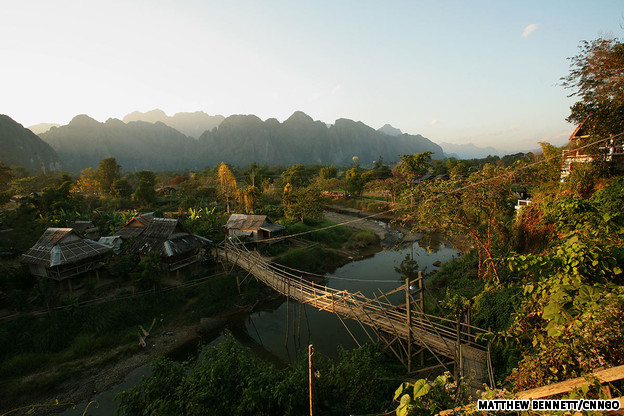
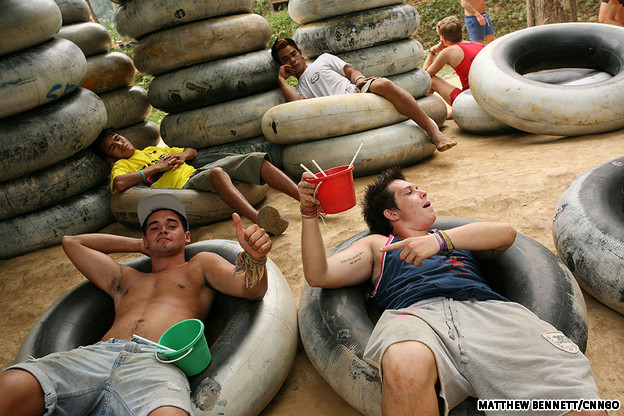
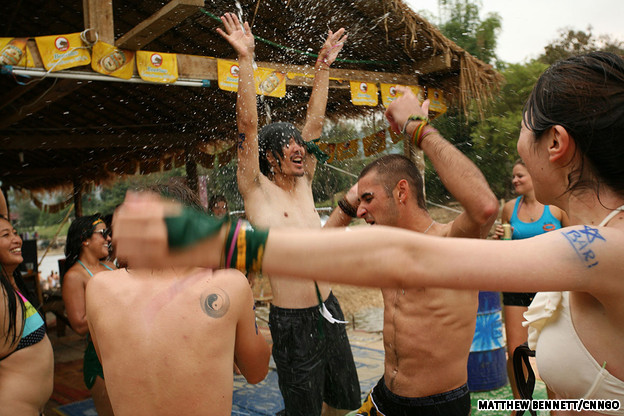
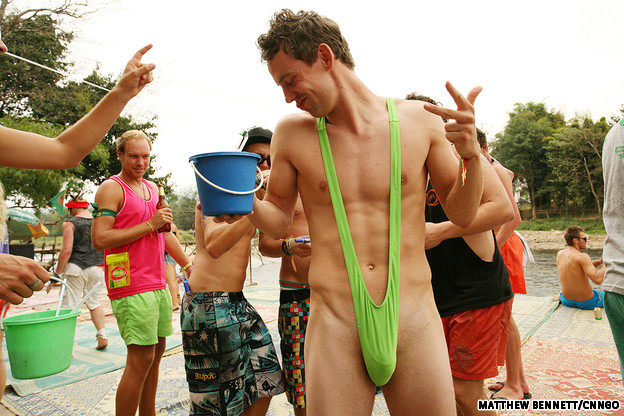
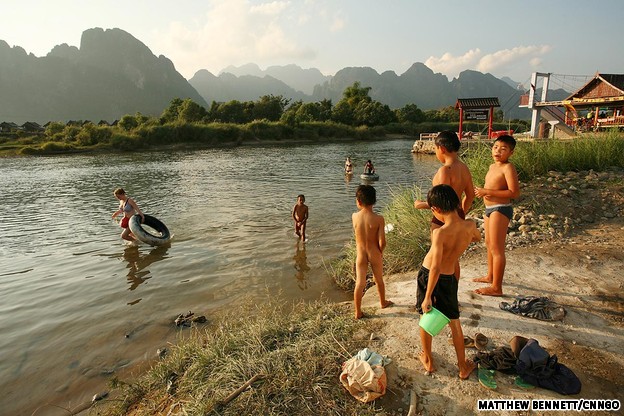
How a sleepy Lao village has become a booze- and drug-fueled party town
By Matthew Bennett 1 March, 2012 Tweet
View over the Nam Song River in Vang Vieng, Laos. Southeast Asia's newest party spot?
Magic mushroom shake? Opium pizza? Bucket of whiskey anyone?
Welcome to Vang Vieng, former traditional farming village, now hot point of drugs, booze, techno and partying and Laos’ hottest backpacker haunt.
The rise -- perhaps that should be fall -- of this town sitting on the Nam Song River and surrounded by beautiful karst scenery, has been dramatic, and its notoriety has spread far.
You are more likely to see topless tourists vomiting than you are local culture and it has been written: “If teenagers ruled the world, it might resemble Vang Vieng.”
It has hit the headlines most dramatically in recent months for the deaths of at least two Australian tourists while tubing on its river.
So what is it really like to spend a few days here?
Travelers taking it easy in inflatable tubes down by the river.
I first came to Vang Vieng in 2000, when, though already popular with spliff-smoking hippie types, it was quiet and peaceful.
In the last five years, coinciding with the launch of inner-tubing on the river, tourism and all that goes with it has overwhelmed the old life.
The tubing rental office tells me that up to 500 tubes are hired out each day during peak periods. One local says one new guesthouse starts construction each week.
Built on wooden platforms over the water, the bars offer cheap drinks and party music to the massive number of backpackers flooding into the town.
Most noticeably, drunk, drugged-up, sleep-deprived, half-naked travelers now wander the streets and the riverbank like lost festival-goers.
And surprisingly, the locals, at least the younger ones, don’t mind. They seem to welcome it.
Buon My, 19, came to the town three years ago to work in a guesthouse and improve his English. “The work's easier here,” he says. “Rice farming is hard and my parents are happy I’m here. I can use the money I earn to pay for my younger brother and sister to go to school, and when I go home the people in my village think I’ve got a cool job.”
One of the more bizarre outfits found in the bars along the river.
His family is aware of what goes on in Vang Vieng, but the income generated makes such a difference in their lives they’re happy to compromise.
One day Buon hopes to own a guesthouse himself, aware of just how much money he can make from tourism.
“This place will just get bigger and bigger,” he predicts. “In the future I want to have my own place, and then I can really make some money and improve the lives of all my family.”
Many locals are concerned that the decadence and exhibitionism of tourists is having a negative effect on the youth of the area.
The town itself has had a rocky history since it was first settled in 1353.
Renamed by the French colonialists and then used as an air base by the Americans during the Vietnam War, the locals are used to change.
Tourism first arrived here for adventurous travelers looking to go rock climbing in the nearby hills or explore the caves dotted around the countryside, or simply to enjoy the tranquility of the Lao people and their culture.
A whiskey and Red Bull bucket, the backpacker drink of choice in Vang Vieng.
But things aren’t so tranquil anymore.
Loud music blares most of the day and night from hundreds of bars and cafes that have sprung up. Cafes show endless reruns of “Friends” and “Family Guy” and travelers lie around on cushions smoking cannabis or drunkenly rolling down the main street singing and shouting, half naked in shorts and bikinis.
Drugs are a key attraction and the authorities seem to turn a blind eye. Restaurants offer all sorts of mind-bending combos, advertising mushroom shakes and opium garlic bread for just a few U.S. dollars.
One of the many “Happy” menus that can be found in the town's restaurants.
One place advertises a kilo of weed at US$300, in case you’re planning on a long stay. A small “bucket” of whiskey comes in at US$3.
You only need to wander down the main street to see the barefoot zombies stumbling back to their guesthouses.
That’s if they make it. Not all of them do.
A special tourist police has been set up to make sure those in the worst shape get home, and also to bust a few unlucky drug buyers whom the police randomly pick on.
A "coupon" to collect free drinks later in one of the many bars in town.
The standard fine is around US$600, and you don’t get your passport back until you pay up. It seems everyone is cashing in on the happy atmosphere.
A local man helps a girl out of her inner tube. Many locals have accepted the changes and work in the tourist trade.
The river is carnage central.
Ten years ago a couple of enterprising locals started renting out inner tubes for tourists to float down the Nam Song. Now it’s big business and one of the major attractions for travelers in Laos.
Bars line the route, built on wooden platforms over the river, all offering zip lines, swings, blaring party tunes and cheap booze.
Crude slides, swings, zip lines and platforms have been built at the bars, but with little safety. In 2011, 22 people were reported to have died in the river.
Young locals haul in the floating drunks on pieces of rope, help them out of the tubes then ferry them toward free shots of liquor.
Think “Apocalypse Now” crossed with a Saturday night on Bangkok’s Khao San Road and you start to get the picture.
It’s become so popular that stag parties from England and Australia come all this way just to get drunk on the river, to the bemusement of locals fishing further downstream.
Partying along the Nam Song. Vang Vieng is now Laos’ number one party spot.
Kerry, 22, an English backpacker fresh from the islands of Thailand, is having the time of her life.
“It’s amazing here, the best place we’ve been on this trip,” she tells me as she takes another sip from her bucket of whiskey.
“We’ve been at the tubing the last two days. I don’t think I’ve ever been as drunk as I was yesterday, but the booze is so cheap it’s hard not to get hammered.”
Her boyfriend agrees: “We were going to stay here for just two days, but we’ve already been here four and I can’t see us leaving tomorrow, not if today carries on like this.”
A backpacker slides down a zip line at one of the riverside bars.
Some travelers don’t leave.
Young Europeans and Aussies work the bars for free room and board, although the board is mostly booze.
Their main tasks are to dance on the stages and to write on the half-naked partygoers with permanent markers so they can claim free drinks in the towns’ bars later in the night.
A craze of writing messages on the bodies of partygoers has sprung up in recent years. Many are explicit and sexually orientated, in contrast to the conservative culture of the country.
Dressed as a mix of burlesque dancers and techno ravers -- one girl even has a Spiderman suit on -- they run around tipping whiskey bottles into open mouths and trying to outdo each other in levels of madness and showmanship.
One party trick while I am here is to be sick off the edge of the bar while a friend stands in the river and catches the vomit stream in his mouth. Some things are just wrong anywhere in the world.
There’s a dark side to all this hedonism.
In 2011 up to 22 people were reported to have died on its river, and already this year two Australian tourists have been killed while tubing.
Around 300 people visit the bars every day, generating a good income for the local owners.
It is estimated there’s roughly one death every month on the river, and stories of tubers floating off and washing up dead downstream are abundant.
There’s little in the way of safety. With most casualties so drunk, few police and decent hospitals a bumpy four-hour ride away, most serious accidents are fatal.
So is this destroying the town?
It depends on how you look at it.
A local man secures tubes on the top of a tuk-tuk ready to be taken to the river. Since the introduction of the activity five years ago, the popularity of the town has risen dramatically.
Yes, the peace and quiet of a quaint Laos village is gone, but on the other hand many of the villagers no longer have to spend their days breaking their backs rice farming.
The tubing is run as a cooperative working on a three-month rotation, so all the surrounding villages benefit.
The ever-increasing number of guesthouses, shops and restaurants provide employment that can be sparse in other areas of the country and with all these tourist dollars coming in, more and more local kids are given the chance of a good education.
But this has definitely come at a price.
A woman sells pancakes in front of the construction of a huge hotel complex. With such a massive increase in visitors, guesthouses and hotels are being built at a rate of one a week.
Older villagers complain of the noise and disruption to their traditional lives, crime and drug use has increased amongst young teens, and school kids on their way home are exposed to sights that would normally be reserved for spring break in Cancun.
These factors, however, haven’t stopped the flow of tourists, or the development of the area.
There are plans to build a huge covered market on the old airfield north of town and a new luxury resort will be one of the high-end openings early this year.
It looks like techno and whiskey are here to stay, as long as the thirsty backpackers keep coming and the river keeps flowing.
getting there
Vang Vieng is 160 kilometers north of the capital Vientiane, around four hours by bus depending on the service and 230 kilometers south of the old royal capital Luang Prabang.
There are plenty of guesthouses in town, both on the river and in the center. Wooden bungalows are also an option, with resorts along both sides of the river.
All come with plenty of hammocks for those famous sunsets. Champa Laos is popular, as is Spicy Backpackers and Pan's Place.
Cheap hostels cost as little as US$5 per night, mid-range places come in at around US$25-30 and swanky places go up to US$50.
In the last few years hundreds of restaurants have opened, selling both traditional Laotian food and the standard Western fare.
The Other Side and Banana restaurant seem to be particularly popular, and, of course, in all these places you can catch up on that “Friends” episode you missed in your student days.
TweetinShare1